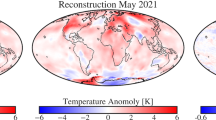Abstract
The spectral structure of stratospheric fields (temperature and geopotential) is analyzed in terms of spherical harmonics in an effort to study the long-term behaviour of large-scale circulation patterns, as well as their connections to some extra-terrestrial effects. The daily meteorological data from the Free University Berlin (FUB) cover more or less the period 1976–1996 and are available for stratospheric levels of 50, 30 and 10 hPa. The analysis of the annual cycle of spherical harmonics is introduced, and changes of the principal wave components are compared with the changes in different sets of solar, geomagnetic and global circulation indices. This paper also deals with interannual variability with special emphasis on quasibiennial oscillations (QBO) and El Nino and Southern Oscillations (ENSO).
Although this is a rather preliminary study, the decomposition of the stratospheric field into complex spherical harmonics seems to be a powerful technique in investigating and qualifying the response of the global atmospheric system to the changes in solar and geomagnetic activity, and in qualifying the relationships between large-scale circulation patterns and various oscillations such as QBO or ENSO, Using this technique, reasonable strong connections were found between wave numbers and interannual factors, and these connections were tentatively interpreted in terms of statistics. A very high degree of correlation was found for the four-trough shape of the polar vortex.
Similar content being viewed by others
References
Baldwin M.P. and Dunkerton T.J., 1997: Biennal, Quasi-biennial and decadal oscillations of PV in the northern hemisphere, J. Geophys. Res. (in press).
Bochníček J., Bucha V., Hejda P. and Pýcha J., 1993: Winter air surface temperatures in the northern hemisphere at different levels of geomagnetic, or solar activity and QBO phases, Ann. Geophysicae, 11,Supplement III, C368.
Bourke W.M., Mc Avaney B., Puri K. and Thurling R., 1977: Global modelling of atmospheric flow by spectral methods. In: J. Chang (Ed.), Methods in Computational Physics, Vol. 17, General Circulation Models of the Atmosphere, Academic Press, 267–324.
Bucha V., 1993: Direct relations between solar activity and atmospheric circulation, its effect on changes of weather and climate. Studia geoph. et geod., 27, 19–45.
Gerstengarbe F.W., Werner P.C., Busold W., Ruge U. and Wegener K.O., 1993: Katalog der Grosswetterlagen Europas nach Paul Hess und Helmuth Brezowski 1881–1992, Bericht 113, Offenbach am Main.
Goeber M. and Hense A., 1995: Long term variations of atmospheric synoptic variability: A study based on radiosonde data from Lindenberg. Meteorolog. Z., 4, 51–61.
Halenka T. and Mlch P., 1996: On the relationship between vertical ozone distribution and synoptic situations. Studia geoph. et geod., 40, 192–215.
Haltiner G.J. and Williams R.T., 1980: Numerical prediction and dynamic meteorology. John Wiley & Sons, 477pp.
Holton J.R. and Tan H.-C., 1980: The influence of the equatorial Quasi-Biennial Oscillation on the global circulation at 50mb. J. Atmos. Sci., 37, 2200–2208.
Holton, J R., and H.-C. Tan (1982): The Quasi-Biennial Oscillation in the Northern Hemisphere, J. Met. Soc. Jap., 60,140–148.
Hood L.L., 1995: Solar Cycle Variation of the Stratosphere, STEP Working Group 5 Report.
Hood L.L., Zaff D.A. and McCormack J.P., 1995: Dynamical contributions to midlatitude total ozone trends in winter, Paper OZ.32, Int. Conf. on Ozone in the Lower Stratosphere, Halkidiki (Book of Abstracts, p. 42).
Kodera K., 1991: The solar and equatorial QBO influences on the stratospheric circulation during the early northern-hemisphere winter. Geophys. Res. Lett., 18, 1023–1026.
Labitzke K. and van Loon H., 1988: Association between the 11–year solar cycle, the QBO, and the atmosphere. Part I: The troposphere and stratosphere on the Northern Hemisphere Winter. J. Atmos. Terr. Phys., 50, 197–206.
Machenhauer B., 1979: The spectral method. In: Numerical Methods Used in Atmospherical Models, Vol. II, GARP Publication Series, No. 17.
Naujokat B. and Labitzke K., 1993: Collection of reports on the stratospheric circulation during the winters 1974/75–1991/92, Stratospheric Research Group, Free University Berlin.
Petzold K., Naujokat B. and Neugebohren K., 1994: Correlation between stratospheric temperature, total ozone, and tropospheric weather systems. Geophys. Res. Lett., 21, 1203–1206.
Salby M.L., 1995: Evidence of solar variability in the atmosphere: The solar cycle variation of the stratosphere, STEP WG5 Report, 16pp.
Tinsley B.A. and Dean G.W., 1991: Apparent tropospheric response to MeV-GeV particle flux variations. J. Geophys. Res., 96, 22283–22296.
van Loon H. and Labitzke K., 1993: Review of the decadal oscillation in the stratosphere of the northern hemisphere. J. Geophys. Res., 98, 18919–18922.
Author information
Authors and Affiliations
Rights and permissions
About this article
Cite this article
Halenka, T., Mlch, P. On the Spectral Decomposition of Geopotential and Temperature Fields in the Stratosphere. Studia Geophysica et Geodaetica 42, 147–158 (1998). https://doi.org/10.1023/A:1023305020573
Published:
Issue Date:
DOI: https://doi.org/10.1023/A:1023305020573




